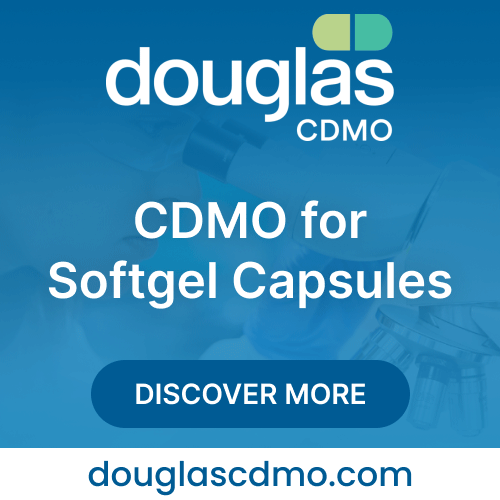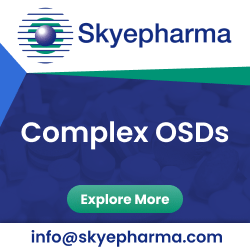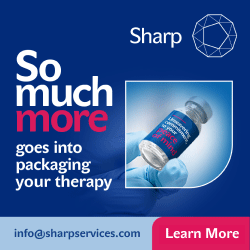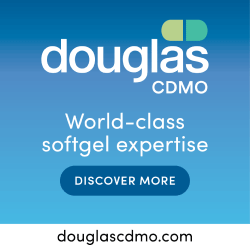Overview of softgels capsule manufacturing & soft gel technologies for the bioavailability enhancement of oral softgel, solid dosage forms.
Q1. What are softgels or soft gelatin capsules?
A softgel or soft gelatin capsule is a solid capsule (outer soft shell) surrounding a liquid or semi-solid center (inner fill). An active ingredient can be incorporated into the outer shell, the inner fill, or both.
Softgel capsules address a broad array of formulation challenges, often incorporating a variety of pharmaceutical-approved lipid-based excipients. Formulation flexibility is a hallmark of softgel formulation and soft gelatin capsule technology.
For the right API, soft gel capsules are an ideal delivery technology that can be used to improve the bioavailability of poorly soluble drug ingredients and deliver precise dosages, quickly and efficiently.
It is important that softgel capsule manufacturers fully understand the stability characteristics and softgel manufacturing considerations involved in making soft gel products. Where resources are strained, soft gel expertise and softgel production capacity are fast-becoming the benchmark of modern, full-service softgel CDMOs (contract development & manufacturing organizations).
Proven applications of softgel dosage forms:
- Bioavailability
Allows multi-fold improvement in bioavailability as demonstrated in preclinical and clinical studies
- Dose Uniformity
Assures dose uniformity of low dose APIs
- High Potency
Provides safe handling of high potency APIs
- API Stability
Constitutes a suitable dosage form for oxygen and/or light sensitive APIs and APIs with a low melting point
- Dietary Supplements
Soft gelatin capsules, also known as soft gels, are the leading formulations for dietary supplements & multivitamin capsules.
Advantages of soft shell capsules over other delivery forms:
- Simpler soft gelatin capsule manufacturing process (commercial manufacturing) with fewer softgel production steps
- The possibility to encapsulate most types of, semisolid, and liquid fill formulations
- Unique color and shape configurations for enhancing product identity
- Easy to swallow and neutral in odor and flavor, improving patient compliance
- Rapid absorption of soft gelatin capsule ingredients
- Soft gel capsules provide pharmaceutical companies with an effective means of delivering poorly soluble active pharmaceutical ingredients (APIs).
- Soft gelatin capsules are hermetically sealed and airtight making them tamper-evident and shielding them from light and oxygen.
Q2. What are the different soft gelatin capsules ingredients?
Soft shells are a combination of gelatin, water, opacifier and a plasticizer such as glycerin and/or sorbitol(s). The outer capsule shell is composed of a gelatin or potato starch matrix. Gelatin matrix consists of gelatin, plasticizer, solvent and optional soft gelatin capsule ingredients such as flavors and colorants. Depending upon the formulation, the outer shell of the capsule can protect the active ingredients and inner fill materials from oxygen or light exposure.
Outer Capsule Shell Ingredients:
1. Gelatin: (E.g. Bovine, Porcine, Piscine or Vegicap alternatives)
Gelatin is an animal protein made by boiling the collagenous material from animal bones, hides, and skin. Depending on its source, gelatin can be divided into two types; Type A, from acidic hydrolysis of animal skin, and Type B, from basic hydrolysis of bovine bones.
Gelatin is one of the most crucial soft gelatin capsule ingredients used by soft gel capsule manufacturers and can only be used once it has been approved by regulatory authorities. Furthermore, approval is only granted when it satisfies minimum specifications relating to gel strength, viscosity, particle size distribution, etc.
Now, there is a vegetarian alternative - vegetarian softgel capsules - which are derived from carrageenan, an all-natural, plant-based seaweed extract. Vegetarian softgel manufacturers make vegetarian softgel capsules, which enable the drug product to appeal to more consumers with dietary restrictions. Vegetarian soft capsules also have the following advantages; they are tasteless, easier to swallow, and quick to absorb.
2. Plasticizer: (E.g. Glycerin & Sorbitol)
Plasticizers are used mainly for oral solid dosage forms to facilitate oral pharmaceutical applications. Plasticizers are added to polymers used as film forming agents in order to make them pliable and soft, thereby enhancing the flexibility and plasticity of the films. In case of soft gel capsules, non-volatile plasticizers that complement gelatin molecules are used.
3. Solvent: (E.g. Water)
Water is used as a solvent in soft gelatin capsules. Water forms a very crucial soft gelatin capsule ingredient of the outer shell. As a testament to its importance, water occupies about 30 – 40 % of the overall wet gel formulation. It further compliments the processing procedure, especially during gel formulation and soft gelatin encapsulation.
4. Opacifiers: (E.g. Titanium Dioxide)
Opacifiers provide protection against light and photodegradation. They also play a role in concealing the soft capsules’ inner fill contents.
5. Preservatives: (E.g. Antioxidant, Antimicrobial & Chelating Agents)
These agents play a role in the preservation of soft capsule contents, which increase their shelf life and make soft-gels safe for consumption.
6. Flavorings: (E.g. Essential oils, Sucrose, etc.)
Flavoring agents are used to achieve taste masking in solid dosage forms (softgel capsules, tablets, etc.) in order to make them more suitable and acceptable for ingestion.
7. Colorants: (E.g. Dye, Lakes, Mineral Colors, etc.)
Coloring agents can impart various colors to softgel dosage forms. Colorants play an important role in improving patient compliance and can be further selected to complement the disease being treated.
8. Other Additives
Fill Material Types:
1. Oily Mixtures: (E.g. Undiluted Mineral or Vegetable Oils)
Oily mixtures may be referred to as neat substances since they purely consist of oily liquids. A neat substance is a sample which is conducted in a liquid phase, without any solvent.
2. Solutions: (E.g. Soft gelatin capsule ingredients - Polyethylene Glycols)
Oral solutions are clear liquid preparations for oral use containing one or more active pharmaceutical ingredients (API) dissolved in a suitable medium (solvent).
3. Suspensions: (E.g. Soybean Mixed with Beeswax, glycerides, etc.)
Suspensions are widely used as liquid softgel dosage forms. They may be defined as preparations containing finely divided drug particles (active ingredients) distributed somewhat uniformly throughout a medium in which the drug exhibits a minimum degree of solubility.
Q3. What are the steps involved in softgel manufacturing?
Soft capsules, also known as soft gels, are a growth market. But producing them is challenging. Getting the formulation just right, while ensuring softgel production efficiency and effective API delivery, calls for in-depth understanding of the soft gel market and the soft gelatin capsule manufacturing process.
Steps involved in softgel manufacturing undertaken by various soft gelatin capsule manufacturers:
Step 1: Gelatin Preparation
Gelatin preparation is the process of blending and heating granulated gelatin and other ingredients in warm water in a gelatin melting tank. With appropriate heat, mixing and vacuum, the ingredients form a thick syrup called a "gel mass" for use in soft gelatin encapsulation. Color may be added during the melting process or in a separate machine.
Step 2: Fill Material Preparation
Fill material in softgel capsules refers to the substance that you encapsulate or seal inside the gelatin soft shell. Oily mixtures, solutions or suspensions are prepared containing active ingredients and excipients that elicit desired therapeutic effects upon consumption.
Step 3: Soft Gelatin Encapsulation
After the gelatin and fill materials have been weighed and prepped, and the appropriate softgel encapsulation machine has been selected, encapsulation may commence. Soft gelatin encapsulation is completed in the five steps noted below.
Step 1: The prepared inner fill and outer fill materials are transported to encapsulation bays.
Step 2: Each softgel encapsulation machine for capsule manufacturing is segregated into individual bays.
Step 3: Molten gel is pumped into the machines.
Step 4: Two thin ribbons of gel are formed, on either side of the softgel encapsulation machines.
Step 5: The ribbons are passed over a series of rollers and dies that help in determining the size of the capsules.
Step 4: Drying
Following soft gelatin encapsulation, the resultant compounds are tumble dried and cured via supplemental drying. Drying occurs by tumbling or by a combination of tumbling and tray drying. Tumble dryer refers to a comparatively large basket which rotates as a way of removing excess moisture from the softgel capsule.
After the softgels come out of the tumble dryers they may be placed on paper lined drying trays. The trays are then stacked on dollies and pushed into drying tunnels for further dring. This method is referred to as tray drying.
Step 5: Cleaning, Inspection and Sorting
After drying, the softgel capsules undergo a series of cleaning (eg. dedusting, polishing, etc.), inspection (eg. size, shape, etc.) and sorting steps prior to packaging , after which the soft gel capsules are ready for storage and distribution by soft gel capsule manufacturers.
Various soft gelatin capsule manufacturers use the following soft gelatin capsule manufacturing processes:
- Plate process
- Rotary die process
- Reciprocating die process
- Accogel process
- Seamless process
- Etc.
Softgel capsules offer unparalleled dosage-form flexibility:
- Encapsulation of a wide variety of fill formulations
- Wide array of sizes, shapes, colors and forms
- Oral, topical, ophthalmic and vaginal administration
Q4. What are the different factors to take into consideration during softgel contract manufacturing?
Softgel contract manufacturing is carried out to produce a number of different drug delivery systems:
• Orally administered softgels: These soft capsules contain solutions or suspensions that release their contents in the stomach in an easy-to-swallow, convenient unit dose form.
• Chewable softgels: With new ingredients, special shapes and flavors, chewable softgels serve as solutions and line extensions to existing products. In chewable softgels a highly flavoured shell is chewed to release the drug liquid fill matrix. Chewable softgels are becoming increasingly popular unit dose solid dosage forms.
• Suckable softgels: They consist of a gelatin soft shell containing the flavoured medicament to be sucked and a liquid matrix or just air inside the capsule.
• Soft capsules with a twist-off caps: These capsules allow access to a measured dose for topical and/or oral applications. They are designed to be twisted or snipped off. This softgel dosage form is commonly used in the cosmetic industry.
• Meltable softgels: Designed to be used as patient-friendly pessaries or suppositories.
Softgels manufacturing is vastly different from two-piece hard capsule manufacturing or tablet contract manufacturing. As such, soft gelatin capsule manufacturers take different considerations into account prior to commencing softgel contract manufacturing or commercial manufacturing.
Some of the most important factors affecting softgel capsule manufacturing are:
1. Compatibility of the drug with gelatin (and shell components)
2. Stability of the drug with moisture
3. Stability of the drug at temperature 35°C to 40°C
4. Migration of drug substances into the capsule shell
5. pH of the fill material
6. Equipment Speed
7. Equipment Quality
8. Equipment Versatility
9. Drying Process
10. Equip Employees
11. Gelatin Formula
12. Process Assessment
Q5. What are vegetarian softgel capsules? What are the advantages?
The global vegetarian softgel manufacturing (veg softgel contract manufacturing) market is driven by growing concerns among people for maintaining healthy lifestyles and the increasing demand for dietary supplements & softgel capsules. Moreover, an increase in the geriatric population who use these capsules to maintain good health has supplemented the market growth.
The general health industry consumer trend points towards a clear increase in demand for natural products and innovative softgel dosage form solutions. In response to widespread consumer demand for natural vegetarian softgel manufacturing, animal free soft gelatin capsules were developed by veg softgel manufacturers.
The manufacturing process is similar to that of an ordinary gelatin soft capsule. However, In vegetarian softgel manufacturing, various softgel CDMOs (contract development & manufacturing organizations for softgel capsule contract manufacturing) use derivatives extracted from algae instead of gelatin for their capsule shells.
Vegetarian softgel manufacturing by veg softgel manufacturers meets the growing demand for clean labels and natural products that are free from animal derivatives. This newest dosage form provides superior thermal stability which exceeds that of animal gelatin, and satisfies the vegetarian and vegan requirements of consumer bases.
Moreover, consumers value the odorlessness and the smooth surface of soft gels and even mini-capsules, which makes them easy to swallow. Newer trends point towards seamless capsules which come in sizes of a few millimeters and are ideal for those experiencing dysphagia. The capsules can be easily digested and the active ingredients are readily available for absorption in the intestine.
Advantages of vegetarian soft gel capsules:
- Vegetarian softgel capsules are easy to swallow.
- Veggie softgels are chemically stable and have low moisture content, which makes them less brittle even in low humidity.
- Along with chemical stability, veggie caps have fast dissolution property. Therefore, they dissolve quickly within a few minutes after reaching the stomach, thus increasing the rate of bioavailability.
- Dosage form flexibility due to variety in shapes and sizes of capsules.
- Increased patient compliance due to odor & taste masking.
- Aesthetically pleasing due to the use of various coloring agents.
- Vegetarian softgels can meet the necessary claims for not just vegetarianism, but halal, kosher, and non-GMO product claims.
Q6. Who are the leading soft gelatin capsule contract manufacturers or softgel CDMOs in the industry?
Some of the leading soft gelatin capsule contract manufacturers ( softgel CDMOs) & veg softgel manufacturers, offering softgel technologies for bioavailability enhancement, in the industry are:
Softigel
Softigel® by Procaps is a leading provider of contract development and manufacturing services & soft gel technologies for the global pharmaceutical and nutraceutical industry. Softigel is an integrated softgel CDMO (contract development & manufacturing organization) & veg softgel manufacturer, giving customers full-service, commercial manufacturing services for prescription drugs, OTC, dietary supplements & multivitamin capsules, across both development and delivery.
Softigel also functions as a veg softgel manufacturer by offering vegetarian soft gel technologies and softgel capsule contract manufacturing. They produce polysaccharide-based soft shell capsules which are free from animal derivatives, and contain carrageenan, modified starch, plasticizers and water. They offer opportunities to bring more products to market, better acceptance by religious and vegetarian groups, and compatibility with a broader range of high pH fill formulations.
Polpharma
Polpharma is a modern international pharmaceutical company that offers prescription-only medicines and medicines restricted to hospital use, OTC medicines, food & dietary supplementsb, and medical devices.
Polpharma also provides contract manufacturing services for various oral solid dosage forms such as soft gelatin capsules, hard capsules, multivitamin capsules (filled with powders, pellets, granules), tablets, multilayer tablets, film and sugar coated tablets.
Capsugel
Capsugel is a pharmaceutical empty capsule and softgel contract manufacturer that has more than 20 years of experience in hard gel & soft gelatin capsule technologies for bioavailability enhancement along with softgel capsule contract manufacturing services.
SGcaps® - their one piece capsule made from their soft gelatin capsule technology for bioavailability enhancement , features an easy-to-swallow capsule shell consisting of plasticizers (glycerin, sorbitol, PEG) that meet all cGMP guidelines, FDA and MEA purity standards and feature a Certified QA system for traceability of raw materials.
Madras Pharmaceuticals
Softgel Healthcare, an associate of the reputed Madras Pharmaceuticals, provides outsourcing solutions to the pharmaceutical and nutraceutical industry. The softgel contract manufacturer offers a state of art and dedicated encapsulation facility for softgel contract manufacturing in Chennai, India.
Softgel Healthcare provides quality products and services that meet National and International Standards. The facility has been designed as per the latest regulatory standards and has undergone audits by several reputed regulatory agencies.
All Suppliers

















 End-to-end drug development, specializing in high-potency softgels and liquids, providing global partners with a competitive advantage.
End-to-end drug development, specializing in high-potency softgels and liquids, providing global partners with a competitive advantage.








